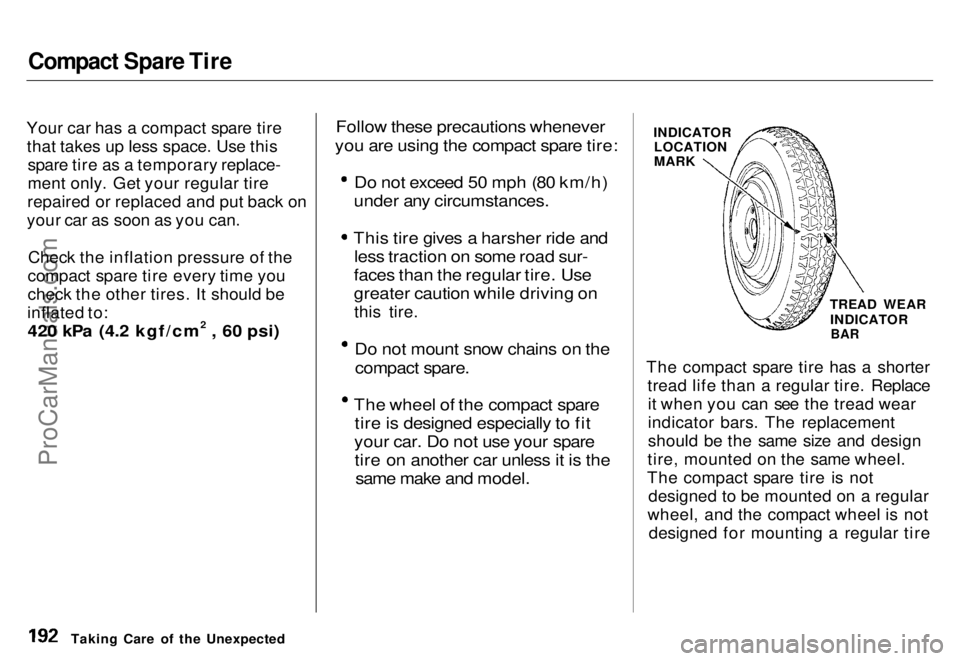Page 182 of 240

Appearance Care
Regular cleaning and polishing of
your Honda helps to keep it "new"
looking. This section gives you hints on how to clean and preserve your
car's appearance: the paint, bright-
work, wheels and interior. Also included are several things you can
do to help prevent corrosion. Exterior Care.................................. 184
Washing...................................... 184
Waxing........................................ 184
Aluminum Wheels..................... 185 Paint Touch-up........................... 185
Interior Care................................... 186
Carpeting.................................... 186
Fabric.......................................... 186
Vinyl............................................ 186
Seat Belts.................................... 187
Windows..................................... 187
Air Fresheners........................... 187
Corrosion Protection..................... 188
Body Repairs.................................. 189
Appearance CareProCarManuals.comMain Menu s t
Page 184 of 240

Exterior Care
Waxes — A wax coats the finish and protects it from damage by exposureto sunlight, air pollution, etc. You should use a wax on your Honda
when it is new.
Polishes — Polishes and cleaner/
waxes can restore the shine to paint that has oxidized and lost some of itsshine. They normally contain mild
abrasives and solvents that remove
the top layer of the finish. You should use a polish on your Honda if
the finish does not have its original shine after using a wax.
Cleaning tar, insects, etc. with
removers also takes off the wax.
Remember to re-wax those areas, even if the rest of the car does not
need waxing.
Aluminum Wheels
On some models
Clean your Honda's aluminum alloy
wheels as you do the rest of the exterior. Wash them with the samesolution, and rinse them thoroughly.
The wheels have a protective clear- coat that keeps the aluminum from
corroding and tarnishing. Using
harsh chemicals, including some commercial wheel cleaners, or stiff
brushes can damage this clear-coat. Only use a mild detergent and soft
brush or sponge to clean the wheels.
Paint Touch-up
Your dealer has touch-up paint to match your car's color. The colorcode is printed on a sticker on the
driver's doorjamb. Take this code to
your dealer so you are sure to get the correct color.
Inspect your car frequently for chips
or scratches in the paint. Repair
them right away to prevent corrosion
of the metal underneath. Use thetouch-up paint only on small chips
and scratches. More extensive paint
damage should be repaired by a
professional.
Appearance CareProCarManuals.comMain Menu s t Table of Contents
Page 187 of 240

Corrosion Protection
Two factors normally contribute to causing corrosion in your car:
1. Moisture trapped in body cavities. Dirt and road salt that collects in
hollows on the underside of the car stays damp, promoting
corrosion in that area.
2. Removal of paint and protective coatings from the exterior and
underside of the car. Many corrosion-preventive measures
are built into your Honda. You can
help keep your car from corroding
by performing some simple periodic
maintenance:
Repair chips and scratches in the
paint as soon as you discover them.
Inspect and clean out the drain
holes in the bottom of the doors and body. Check the floor coverings for
dampness. Carpeting and floor
mats may remain damp for a long
time, especially in winter. This dampness can eventually cause
the floor panels to corrode. Use a high-pressure spray to clean
the underside of your car. This is especially important in areas that
use road salt in winter. It is also a
good idea in humid climates and areas subject to salt air. Carsequipped with ABS have a sensor
and wiring at each wheel. Be
careful not to damage them. Have the corrosion-preventive
coatings on the underside of your
car inspected and repaired periodically.
Appearance CareProCarManuals.comMain Menu s t Table of Contents
Page 190 of 240

Compact Spare Tire
Your car has a compact spare tire that takes up less space. Use this spare tire as a temporary replace-
ment only. Get your regular tire
repaired or replaced and put back on
your car as soon as you can.
Check the inflation pressure of the
compact spare tire every time you
check the other tires. It should be
inflated to:420 kPa (4.2 kgf/cm2 , 60 psi)
Follow these precautions whenever
you are using the compact spare tire:
Do not exceed 50 mph (80 km/h)
under any circumstances.
This tire gives a harsher ride and
less traction on some road sur-
faces than the regular tire. Use
greater caution while driving on
this tire.
Do not mount snow chains on the
compact spare.
The wheel of the compact spare
tire is designed especially to fit
your car. Do not use your spare tire on another car unless it is the
same make and model.
INDICATOR
LOCATION
MARK
TREAD WEARINDICATOR
BAR
The compact spare tire has a shorter tread life than a regular tire. Replaceit when you can see the tread wear
indicator bars. The replacement
should be the same size and design
tire, mounted on the same wheel.
The compact spare tire is not designed to be mounted on a regular
wheel, and the compact wheel is not designed for mounting a regular tire
Taking Care of the Unexpected
ProCarManuals.coms t Main Menu Table of Contents
Page 193 of 240
Changing a Flat Tire
9. Loosen the five wheel nuts 1/2
turn with the wheel wrench.
LX model:
Do no
t attempt to forcibly pry the
wheel cover off with a screwdriver or
other tool. The wheel cover
cannot b
e removed without first
removing
the wheel nuts. 10.Find th
e jacking point nearest the
wheel yo
u are removing. Place th e
jac
k under the jacking point. Turn
the en
d bracket clockwise until
the
top of the jack contacts the
jacking point. Make sure the
jacking point tab is resting in the jack notch. 11.Use the extension and wheel
wrench as shown to raise
the car
until the flat tire is off the ground.
CONTINUED
Taking
Care of the Unexpected
WHEEL
NUTS
JACKING POINT WHEEL WRENC
H
EXTENSION
ProCarManuals.comMain Menu s t Table of Contents
Page 194 of 240
Changing a Flat Tire
12.Remove the wheel nuts and flat tire. Temporarily place the flat tireon the ground with the outside
surface of the wheel facing up.
You could scratch the wheel if you put it face down. BRAKE HUB
13.Before mounting the spare tire, wipe any dirt off the mountingsurface of the wheel and hub with
a cloth.
14.Put on the spare tire. Put the
wheel nuts back on finger-tight,then tighten them in a crisscross
pattern with the wheel wrenchuntil the wheel is firmly against
the hub. Do not try to tighten
them fully.
Taking Care of the UnexpectedProCarManuals.comMain Menu s t Table of Contents
Page 195 of 240
Changing a Flat Tire
15.Lower the car to the ground and remove the jack.
16.Tighten the wheel nuts securely in
the same crisscross pattern. Have
the wheel nut torque checked at
the nearest automotive service
facility.
Tighten the wheel nuts to:
108 N.m (11 kgf.m , 80 Ibf.ft)
17.Put the flat tire in the supplied vinyl bag.
E
X model:
Remove the center cap.
CONTINUED
Taking Care of the Unexpected
ProCarManuals.comMain Menu s t Table of Contents
Page 196 of 240
Changing a Flat Tire
18.Remove the spacer cone from the wing bolt, turn it over, and put itback on the bolt.
19.Install the flat tire and storage bin on the side panel as shown. Secure
them by screwing the wing boltback into its hole. 20.Put the spare tire cover in the
storage bin.
21. Knot the top of the vinyl bag as
shown.
22.Store the jack in its holder. Turn
the jack's end bracket clockwise to
lock it in place. Replace the tool
tray and store the tool kit. Installthe armrest pad.
23.Store the wheel cover or center cap in the cargo area. Make sure it
will not get scratched or damaged.
Taking Care of the Unexpected STORAGE BINProCarManuals.comMain Menu s t Table of Contents